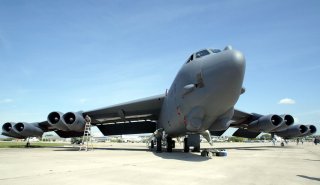Upgrade Time: U.S. Air Force is Calling for New B-52 Engines
But why now?
The United States Air Force’s fleet of B-52 bombers has been operating since the late 1950s, and likely will do so for decades to come, which is why the old warbirds still require regular maintenance and upgrades. This week the Air Force issued a Request For Proposal (RFP) on the B-52H Commercial Engine Replacement Program, which has called for responses by July and a contract award that is expected in June 2021.
A total of 608 engines along with additional spare engine parts and support equipment are required, and the engines and parts are to be delivered over the next 17 years—which can keep the bombers operational at least until 2050.
Three major aerospace companies have already said they’ll be competing for the lucrative contract including GE Aviation, Raytheon Technologies’ Pratt7 & Whitney unit and Rolls-Royce. The companies are already under contract to create digital prototypes and have until July 22 to submit final proposals.
The United States Air Force currently operates 76 B-52s and these are each outfitted with eight Pratt & Whitney TF33-PW-103s, which have powered aircraft since the early 1960s.
This may or may not give Pratt & Whitney an edge however. The Air Force has made it clear that it would want a military derivative of a commercial engine to replace the existing engines, and according to Flight Global GE Aviation plans to offer two options: CF34-10s, which power commercial aircraft such as the Bombardier and Embraer regional jets, and the Passport turbofans, which power Bombardier’s Global business jet.
“GE is the only company to have been involved in re-engining U.S. Air Force aircraft three times over,” said spokesman David Wilson as reported by DefenseNews. “Add in our deep experience powering six strategic bombers, entrenched support of air combat and the reverence we have for the role we play in protecting this country, and GE is the clear partner to ensure the B-52 is ready at all times for mission critical.”
Pratt & Whitney is reported to offer the PW800, which is used to power the Gulfstream G500 and G600 business jets; while Rolls-Royce will offer the F130 engine, a military version of its BR700, which is used on Gulfstream business jets among other aircraft.
Chris Johnson, executive director for mobility and diverse engine programs at Pratt & Whitney, highlighted his company’s PW800 to DefenseNews.
“Its industry-leading reliability, robust sustainment infrastructure, and significant fuel efficiency savings will greatly improve the legendary bomber and keep it flying for decades to come,” he explained. “Our unique experience with the B-52, coupled with our expertise integrating commercial engines onto military applications, will deliver a low-risk, high-performance engine to power the Stratofortress fleet through 2050.”
Craig McVay, senior vice president for Rolls-Royce Defense, said in a statement, “Rolls-Royce is excited to move to the proposal stage of the campaign and ready to demonstrate that the Rolls-Royce F130 engine is the perfect fit for the B-52. The F130 is a highly reliable and proven engine which is already in commercial production. Our team is focused and energized, and eager to compete for the B-52 Commercial Engine Replacement Program and provide the best possible solution for the U.S. Air Force and the key missions of the B-52 weapon system.”
In addition to desiring an engine that is of a similar size and has the same thrust and weight compared to the legacy Pratt & Whitney power plants, the Air Force wants it to be a modern turbofan with a higher bypass ratio and digital engine controls. The new engines need to also have reduced fuel consumption, noise, emissions and operating costs. If those requirements for fuel consumption are met the new engines—at least in theory—could increase the current range of 7,650nm by as much as 20% to 40%.
Peter Suciu is a Michigan-based writer who has contributed to more than four dozen magazines, newspapers and websites. He is the author of several books on military headgear including A Gallery of Military Headdress, which is available on Amazon.com.
Image: Reuters

